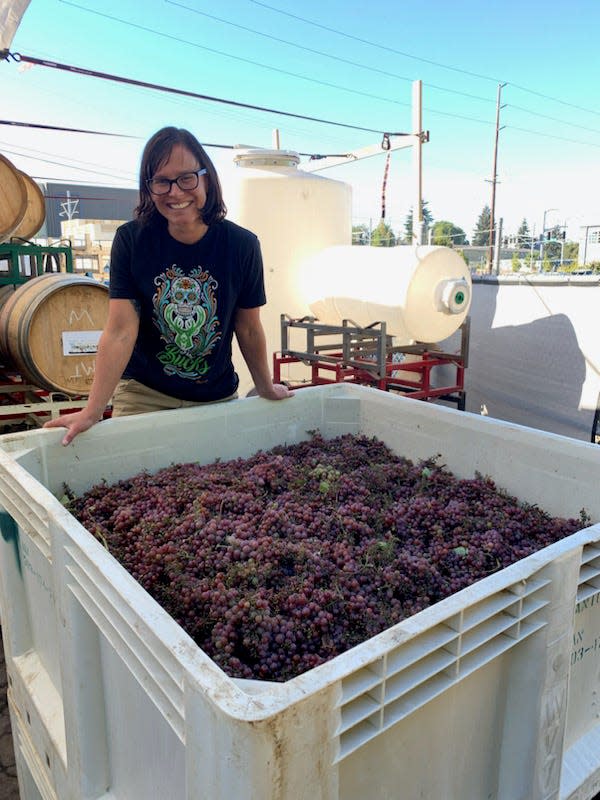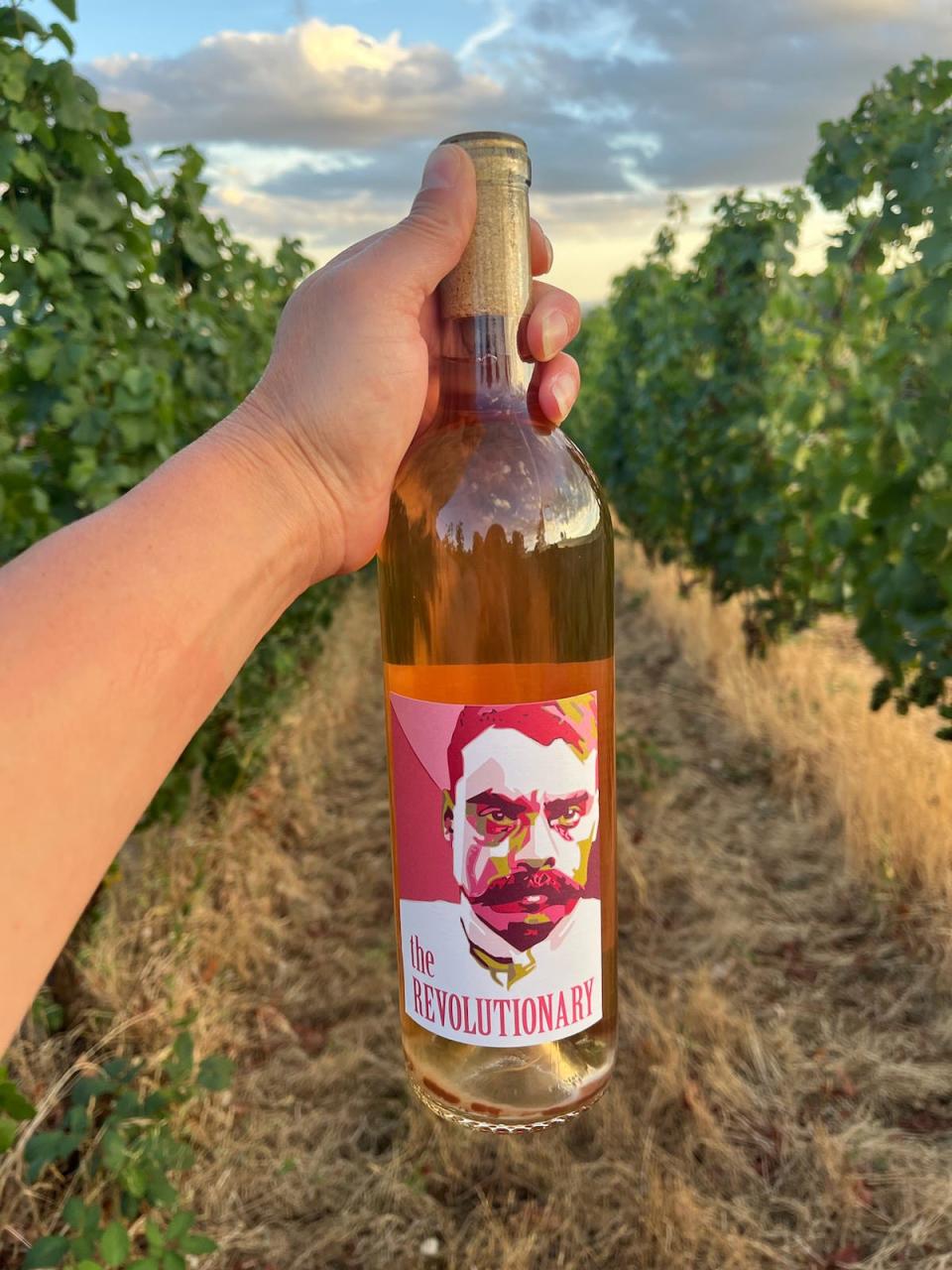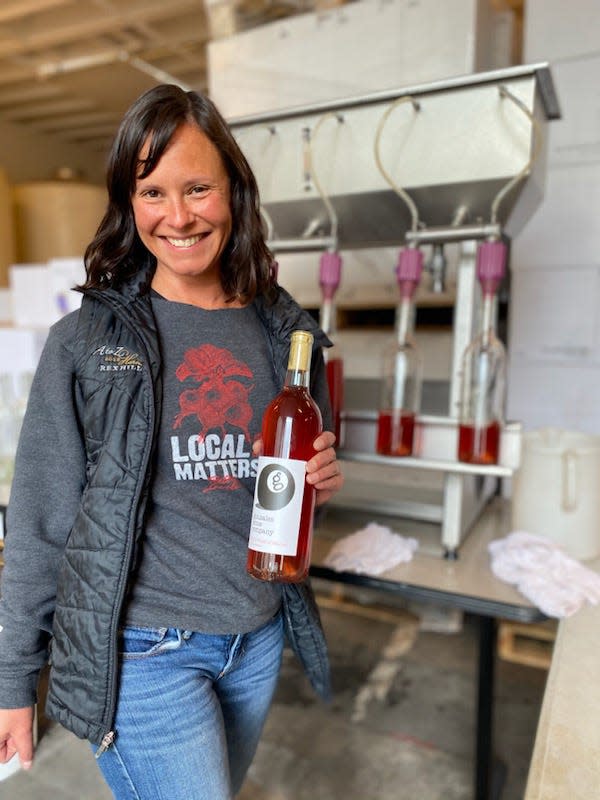Table of Contents
Cristina Gonzales always knew the value of the food on her table. She grew up the granddaughter of migrant farmworkers who landed in Wisconsin to pick cherries, in search of better pay and opportunities.
As an adult, she fell in love with the wine industry while traveling in South America. That set her on her own path, and she spent years traveling the world doing every possible job she could to learn about the wine industry.
After working harvests from California to Tasmania, she worked a harvest in Oregon and fell in love with the region. She settled in Portland, Oregon, in 2009, and in 2010 founded her own winery, Gonzales Wine Company.
The Milwaukee native’s heritage and travels all influence her approach. You’ll see it in the grapes she uses and how she chooses to make wine, from her love for malbec and petit verdot to featuring Emiliano Zapata on the labels for her Revolutionary wines. She’s a small, hands-on producer, making around 500 cases per year.
Last year she was in Milwaukee for a wine dinner at The Diplomat, 815 E. Brady St., with James Beard Award winner and fellow Whitefish Bay High School graduate Dane Baldwin.
On Aug. 31, Gonzales will visit Milwaukee for a wine tasting and dinner at Engine Co. No. 3. Wines featured will include her 2021 Revolutionary Petit Verdot, 2021 Oasis Vineyard Malbec, 2022 Oasis Vineyard Riesling, 2022 Revolutionary Rose of Petit Verdot, and the newly released 2022 Alad Vineyard Gewurztraminer. Tickets are $75, at enginecompany3.com.
Gonzales ships her wines nationwide, and in Wisconsin they are distributed by McFarland-based Left Bank Wine. They can be found at select shops including Thelma Carol Wine Merchants, 605 W. Virginia St.; Thief Wine, in the Milwaukee Public Market at 400 N. Water St.; and Waterford Wine & Spirits, 2120 N. Farwell Ave., Milwaukee, and 631 Genesee St., Delafield.
Gonzales recently talked by phone to share her story ahead of her Milwaukee visit.

Her Wisconsin roots
I am biracial. My mom is Polish American, my dad Mexican American. My dad’s family, they were a migrant farm-working family, amongst other things. … They picked cotton and watermelon, whatever was in season, then heard that in Wisconsin you got better pay. They went to pick cherries in Wisconsin. My grandpa and great uncle, they ended up settling in Wisconsin. We’ve got a clan in Waukesha and Milwaukee. … I graduated from Whitefish Bay High School (in 1998). I was a chapter 220 student. I went to UW-Madison for my first year and a half. Then my parents moved to Santa Rosa, California. I wanted to be closer to my parents. I transferred and finished at Humboldt State in northern California.
I fell in love with wine while studying abroad. It was cheaper for me to go to South America than to go to Mexico City, so I ended up in South America — Ecuador, Peru, Chile, Bolivia and Argentina. It was in Argentina that I really started to get interested in wine. … Then having my parents living in Sonoma County in northern California, that was pinot country. I just got a job in a tasting room and started asking questions. I got a job in a cellar in Alexander Valley in Sonoma, then started harvest hopping to gain knowledge. It was a way for me to gain the most experience I could in a short amount of time.
She showcases varietals with intention
I love aromatic whites and bold reds, so that’s what I like to make. I also kind of pick things that are out of the box, out of the status quo.
Here in Oregon, most of the status quo is chardonnay and pinot noir. I like to focus on more obscure varietals and to show people what else Oregon and Washington have to offer, besides what they already know. I do a malbec every year. That’s an homage for how I fell in love with wine in Argentina. My malbecs are not Argentine style in any way. They are more light, fruit-forward. I’m using oak barrels that are seven to 12 years old. You’re not getting that oak influence you’d see in newer oak barrels. They’re basically just acting as holding vessels. I’m trying to showcase the fruit, who is farming, the grapes, and to showcase the wine when it is in bottle.
Vineyard workers are ‘the beating heart’ of the industry
The farming aspect resonates, that’s part of my family history as farmworkers. … Without our vineyard stewards, there are no grapes, there is no wine. I do call them the beating heart of our industry. I’m on the board of a non-profit, AHIVOY, a Hispanic association of the wine industry and community in Oregon. This organization started in 2009 with three Latino winemakers and grape growers in the Willamette Valley: Sofia Torres-McKay, Miguel Lopez, and Jesús Guillén. … They wanted to do something for our vineyard stewards. This is a way to give back. They started an education program, a 16-week program, partnered with a community college and university in the Willamette Valley to offer enology and viticulture classes along with wine business, marketing, wine education and hospitality, to give them the whys of what they’re doing in the vineyard, and also to see what happens to the grapes after they are picked.

A statement wine with a statement label
I started (making) the Revolutionary in 2014. I just wanted to give my son Julian a birth wine. I came across a petit verdot, a blending grape much like malbec was, and I found a little bit of it. It came out so good that we continued to do it year after year. We put Emiliano Zapata on the label because Julian’s first name is Emiliano and where he was born (in Mexico) is the base of the Zapatista movement. My dad’s first name was also Emiliano, and it is a wine to honor our heritage. …
Actually, the Revolution is two wines now, the Rosé of Petit Verdot and Petit Verdot. Not many people have that as a single varietal wine; just like malbec, they are used mostly for blending. I like to champion underdog wines. … I want to show people these grapes can produce outstanding wines when given the chance. The Rosé of Petit Verdot is lovely and bright with acidity and has these strawberry notes and a little bit of citrus, lemon curd, that I get from it as well. This year I topped it up with a little gewurtzraminer and riesling. … So the 2022 Rosé of Petit Verdot is nice with this little lift from the gewurtztraminer and riesling. I’m excited for people to try it.
How an urban winemaker gets her grapes
I purchase from other growers. I make my wine in Portland. I’m considered an urban winemaker, but I source most of my grapes from southern Oregon and eastern Washington, and recently I started getting some grapes from Willamette Valley, like the gewurtztraminer.
Her favorite grape
Malbec. That will always be my first love. The white malbec in 2021, that’s one of my favorites that I’ve ever made. It is such a fun grape to work with and ferment. It is definitely my favorite. … It is coming back for this year, 2023.

What she wants you to think about the next time you buy wine
It is important that people support small producers, especially small producers from marginalized communities who are making wine in an ethical way. Because if you don’t come from a winemaking family or money already, this is a really hard business to eke out a living. First and foremost, I’m a small business owner and a Latina winemaker, and there are not a lot of us out there.
When she comes home, this Milwaukee native’s first stop always includes food
Usually, my first stop is to hit up the first cheese store I see. I am definitely going to be making my way to Mars Cheese Castle and going to Kopp’s for custard and a burger. Then Rocky Rococo, always.
If she could only choose one wine to represent her style, this is it
It is the malbec for sure, the Gold Vineyard Malbec. That is some of the first fruit I ever got when I started Gonzales Wine Company and making malbec in my style, where it is not oak influenced and it is really just showcasing that fruit and where it is from. That fruit in particular is from southern Oregon. Having people be able to taste malbec by itself, that’s what I love to show people.
Starting in September she’ll have her own wine bar
I am opening my own tasting room in Portland with a friend (who operates RAM Cellars). It is called Community Wine Bar, and she is the first trans-woman winemaker in the United States I believe, but definitely here in Oregon. We’re both urban winemakers who have never had a tasting room. … We’ll showcase our wines, but we’re trying to build a welcome and safe space for the BIPOC and queer communities and to make wine accessible, because generally speaking, wine is considered a luxury product. It can be this great tool and conduit for bringing people together, but you have to be able to afford it. You have to create a space.
Fork. Spoon. Life. explores the everyday relationship that local notables (within the food community and without) have with food. To suggest future personalities to profile, email [email protected].
More: At 50, Wollersheim Winery has a woman winemaker in the wings
More: This Baraboo couple got an early start on their retirement dream of owning a winery
This article originally appeared on Milwaukee Journal Sentinel: Cristina Gonzales honors her family’s heritage through her wine company



.png#keepProtocol)




.png#keepProtocol)
More Stories
Employee Appreciation Day: How to build a culture of year-round recognition
Data Never Sleeps Turns 11!
George Jenkins’ Alyssa Currie signs first bowling scholarship in school history